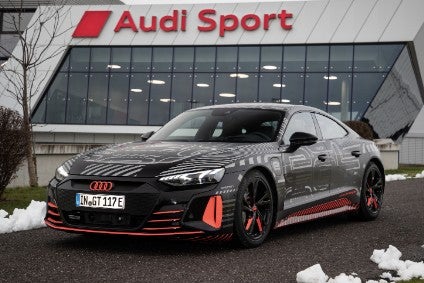
Audi should sell around 650,000 locally made vehicles – mainly sedans – in its number one market this year. Add in 50,000+ imported models and 2020 will have been a good year after all. Yet while China is strong, the US and Europe are less so, plus consumers are buying way fewer TDI models and cars in general. Might more electrification help?
The latest generation, 4,343 mm long A3 Sportback (five-door) was revealed online in March after its planned premiere at that month’s Geneva motor show had to be cancelled. The Sportback, which is three centimetres longer than the car it replaced, is accompanied by a 4,495 mm long A3 Sedan that was announced in April. In North America, the cars are new for the 2021 model year. A 4,554 mm long A3 L Sedan (long wheelbase), which is a special variant for China, premiered at the Guangzhou motor show in November.

Discover B2B Marketing That Performs
Combine business intelligence and editorial excellence to reach engaged professionals across 36 leading media platforms.
Production of the Sportback commenced in March although this didn’t last long as COVID-19 saw all of the Volkswagen Group’s European plants taken offline from the middle of the same month. The first hatchbacks and sedans offered these choices:
- 30 TFSI, 81 kW (110 PS) 999 cc petrol
- 35 TFSI & 35 TFSI MHEV, 110kW (150PS) 1,498 cc petrol (mild hybrid has identical outputs but very slightly better fuel consumption and C02 emissions)
- 30 TDI, 85kW (110PS) 1,968 cc diesel
- 35 TDI, 110kW (150PS) 1,968 cc diesel
There are no replacements for the A3 (three-door) and A3 Cabriolet due to cost cutting and slow sales of the former cars. There might still be a third body style though, as rumours suggest an A3 ‘liftback’ will be part of the line-up. This would serve as the replacement for the TT. Another possible name for this car might be A3 Sportback Coupé.
The A3 Sportback 40 TFSI e plug-in hybrid was announced in September. See the link to PLDB below for details. The A3 range is due for a facelift towards the end of 2023 with the successor scheduled to appear in 2027.
It’s now just under two years until the arrival of the next A4 range. There will again be standard and extended wheelbase sedans, along with an Avant. The car will take on a new level of importance in European countries too, as Volkswagen removes the Passat sedan from sale, the next generation of that model becoming a Variant/estate-only.
The larger A6 continues to be highly successful in China but sales in North America and Europe are dwindling due to the shrinkage of the segment in which it competes. Still, Audi isn’t giving up, as can be seen by the addition of the A6 TFSI e a year ago.
The petrol-PHEV version of the A6 was a world premiere at the Geneva motor show in March 2019. It is powered by the same powertrain as the A8 L 60 TFSI e quattro and A7 Sportback TFSI e.
The lithium-ion battery is made up of 104 pouch cells, which are combined into eight modules. In total, these store 14.1 kWh of energy at 385 V. The cooling circuit of the battery is integrated in the low-temperature circuit, which supplies the electric motor and the power electronics. The power electronics transform the direct current of the high voltage-battery into a three-phase current for the electric motor; when recuperating, it does the opposite. The standard heat pump ensures efficient vehicle climate control and can generate up to 3 kW of heat energy from 1 kW of electrical energy with the waste heat occurring in the vehicle.
The A6 55 TFSI e went on sale in Germany in October 2019 with the Avant added in April just as the Volkswagen Group’s plants in Germany were being restarted after the stoppage due to COVID-19. All versions of the A6 are due to be facelifted from the fourth quarter of 2021. The replacement will follow in 2025. This model will almost certainly be an EV.
Audi will soon be selling a five-metre long electric hatchback in the style of Tesla’s aged, low volume Model S. It could also serve as an eventual replacement for the R8 which some believe will be phased out. Adding to that suspicion is the fact that Audi chose the same plant (Böllinger Höfe) which makes the R8 for production of the e-tron GT. Build commenced a few days ago but the first deliveries are not scheduled until March.
The e-tron GT will also be available in RS form, Audi stated in November. The production model will be revealed shortly.
Production of the R8 is due to end in 2022 or 2023 and although the business case for a new model is said to be marginal. Should the project go ahead, the third generation car could be an EV. Audi is rumoured to be working with Rimac on prototypes of an electric hypercar.
Reports for many other manufacturers’ future models are grouped in the OEM product strategy summaries section of just-auto.com.
Future platform intelligence
More detail on past, current and forthcoming models can be found in PLDB, the future vehicles database which is part of GlobalData’s Automotive Intelligence Center. That includes many other Audi cars not reported on above.
This is the third report in a series which highlights certain current and future models from the passenger vehicle divisions of Volkswagen Aktiengesellschaft. It follows a look at VW cars and another feature on VW SUVs, MPVs and pick-ups. Next, it’s Audi SUVs, then Porsche, Škoda, SEAT and Cupra, Bentley, Lamborghini and Bugatti.






